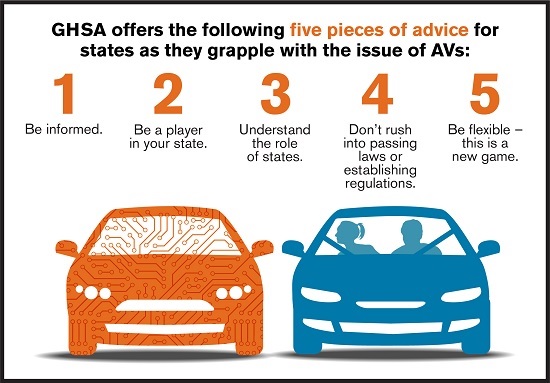Governors Highway Safety Association
As autonomous vehicles (AVs) merge into our nation’s traffic, the most pressing safety challenge for states will be preparing human drivers. While these vehicles have the potential for tremendous safety benefits, AVs will be sharing the road with traditional driver-operated cars for many decades, perhaps forever. And the public remains skeptical.
Currently, only about one-fifth of drivers say they would buy an autonomous car as soon as one is available and fewer than one-third say they would be comfortable riding in one. This presents a myriad of safety challenges for states, which are responsible for educating the public, licensing drivers, and establishing and enforcing traffic laws.

The Governors Highway Safety Association’s new report, Autonomous Vehicles Meet Human Drivers: Traffic Safety Issues for States, authored by Dr. James Hedlund, a former senior official with the National Highway Traffic Safety Administration (NHTSA), examines these issues and recommends how states can prepare for AVs and put traffic safety at the forefront of all policy decisions.
According to Dr. Hedlund, “The research and media attention given to autonomous vehicles often overlooks the safety implications that a mix of driver-operated and autonomous vehicles will bring. Unfortunately, ignoring the driver side of the equation may negate many of the expected safety benefits.”
The report provides an overview of the current autonomous vehicle landscape and outlines suggested priorities for state Departments of Motor Vehicles (DMVs) and State Highway Safety Offices (SHSOs) as AVs become more widespread.
Key recommendations include:
■ Educate the public – States should develop education campaigns on the benefits and risks of AVs, how to operate vehicles with some autonomous features safely, and how to share the road with AVs.
■ Don’t rush into passing laws – States should wait until model laws and regulations have been developed to encourage a common structure and prevent a patchwork of inconsistent laws and regulations that may delay AV implementation.
■ Capture the data – States must identify vehicle automation levels in their registration, driver licensing and crash information systems. Police crash reports should be designed to help facilitate comprehensive and accurate data collection.
■ Engage law enforcement – States should include law enforcement in their planning, as AVs raise many issues for law enforcement, including officer safety, enforcement procedures and vehicle identification.

GHSA Executive Director Jonathan Adkins notes, “Drivers are often forgotten as we discuss autonomous vehicles, but cars driven by humans will be on the road for at least another generation. As human drivers begin to share the road with different levels of autonomous vehicles, states will need to stay informed, be patient and be flexible.”
The report also provides a comprehensive list of resources for additional information and encourages national organizations to help states by developing model laws and public education materials, documenting likely traffic safety scenarios, and establishing a centralized AV clearing house for new information.




